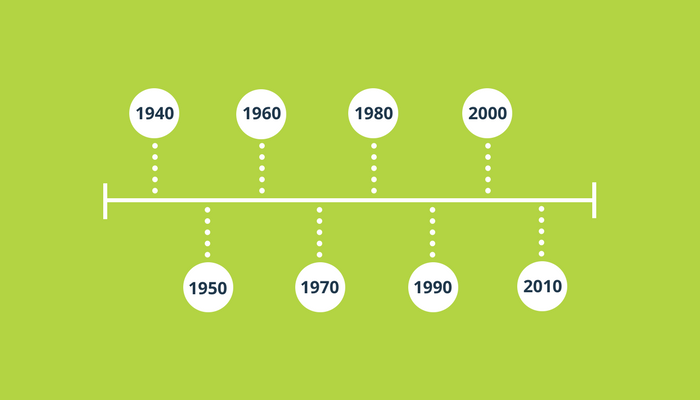TOP TALK
Marketing to Different Generations: Is Your Messaging Age-Appropriate?

Posted By Colleen Irish on March 07, 2018
All of the different generational terms—Baby Boomers, Gen X, Millennials and Gen Z—are thrown around so liberally, it’s enough to make your head spin. They sound more like movie titles than something substantive for brands to pay attention to. But the fact is, there are real distinctions between the purchasing behaviors and attitudes of these different demographics, reflecting the eras they grew up in and the degree to which they’ve adapted to the digitally-focused lifestyle of today.
Here are some of the differences to consider when looking to engage these different audiences using social media and other mediums.
Baby Boomers: “The Retiring Rebels”
Having lived through the 60s and 70s, Baby Boomers (born between 1946 and 1964) chased after their own version of the American-dream and fought for the values they believed in, as captured by the Civil Rights Movement and anti-Vietnam war protests. While not as tech savvy as younger generations, according to this Pew Research study, Boomers have adopted certain online platforms such as Facebook (up to 65%) and Skype to stay in touch with children, grandchildren and close friends, and are mastering the basics of smartphone use to send photos through text.
This demographic accounts for up to 50% of all consumer expenditures, yet marketers typically spend only 10% of their budgets on Baby Boomers. Through the right marketing approach, there is a huge opportunity to grab the Boomer’s mindshare and their extra dollars.
Tips:
- More traditional marketing techniques such as television and newspaper advertisements, direct marketing brochures and even phone sales, work well with this demographic. This group still prefers to talk to a live person than risk having their credit card information compromised through online security breaches, so if you’re going to use digital content here, consider using it to encourage live, one-to-one conversations.
- These empty nesters appreciate nostalgia and have loyalty to big brands that were mainstays of their early years. Think Coca-Cola, Hanes, Old Spice and Mr. Coffee! Creating campaigns that focus on quality and familiar life experiences, like holidays and major milestones, can go a long way with this group.
- Although they may still prefer bargains, research shows Baby Boomers value quality, and are more likely to splurge on themselves in their later years. There’s an opportunity to upsell and build a deeper relationship by delivering more value.
Gen X Marks the Sweet Spot
Gen X (born between 1965 and 1980) are in the thick of life. The majority of this group is in their 40s with kids, mortgage payments, college savings and lots of bills. This group straddles between the world of landlines and snail mail and the rise of email, the iPhone, texting, and instant messaging, following the tech boom of the 90s.
They are similar to Baby Boomers in their love for nostalgia, and tendency to be “wowed” by celebrity endorsements, but they’ve also embraced the digital explosion and have made this a part of their everyday lives. Having been raised by the post-world war generation, they are frugal with their spending but also cherish nice things and brand quality. This group tries out different social platforms such as Instagram and Snapchat, especially when trying to keep up with (and track of) their teens and college kids. They may find a pop-up ad annoying, but not to the point where they’ll block the brand like younger generations.
Tips:
- Since this generation is strapped for time and money, brands would do well to develop campaigns and social outreach that is geared toward convenience, value, improved customer service, simplified checkout and free returns.
- Providing value-added service is a sure way to engender a positive response from this group. And because Gen Xers are not technology shy, providing modern technology capabilities to enhance the shopping experience can result in conversion and customer relationship building for the long haul. For instance, the IKEA Catalog has seen success using an augmented reality feature through its mobile app to give consumers a virtual preview of furniture in a room, allowing for the customer to experience a digital test-run.
On Fleek with Millennials
Extensive research has been done on the Millennial generation (20 to 30-somethings born between 1981 and 1996). Often characterized as self-involved, lazy and demanding, this generation is arguably the most misunderstood of the consumer markets. Yet they are a group with a projected $200+ billion in purchasing power, so it’s well worth the effort spending time getting to know and understand them.
Having experienced big events like 9/11 and the financial crisis, this group is open-minded, passionate and extremely engaged. They began entering the workforce as the economy crashed, and as a result, are the largest generation of entrepreneurs. They grew up with technology at their fingertips and, according to Millennial & GenZ marketing agency Riddle & Bloom, “By taking the time upfront to learn about what this generation cares about, brands can develop stronger, lasting customer relationships. Everyone assumes it’s all about the digital experience with Millennials. Of course, it’s important to engage in social channels where these younger consumers are conversing with friends and family 24/7, but it’s just as important to connect with them offline to create memorable brand experiences.”
Tips:
- Millennials value relationships. They don’t typically respond to traditional advertising, and the same tactics used on Baby Boomers and Gen Xers will more than likely turn off this group altogether.
- Social influencers are a key way to tap into the Millennial generation. Introducing a product through social endorsements and reviews and personalized offers will earn approval and respect with this audience. Research shows five out of six Millennials chose to connect with companies on social media, but they expect their experience to be reciprocal through discounts, free perks, and better customer service.
To have a lasting effect, tap into what makes this group tick, like supporting social causes. For instance, Patagonia pledges 1% of its sales to the preservation and restoration of the environment. Millennials tend to feel good about investing in a brand name behind a cause. It’s important to remember, though, that any attempts at Millennial relevancy need to come naturally, not forced, and as an extension of the brand’s values and messaging.
Post Millennials: Gen Zs
In the last few years, the “digitally savvy” Generation Z (born 1996 to 2010) is on the rise. These younger siblings of Millennials have had a stream of data tracking them since birth, making it easier for marketers to gather personal information about their behaviors and habits.
This demographic has never known a world before the Internet and widespread use of mobile technologies. Gen Zs are the masters of streaming movies and TV shows, bouncing from one social platform to the next in one sitting —and they have many! According to a recent study by Riddle & Bloom of close to 700 Gen Zs, the majority of respondents (82%) have more than 10 apps on their devices and close to half of this group uses more than 41-60% of those apps. Of the apps, 83% fall under social media.
Data shows that Gen Zs are willing to reward brands (through their loyalty) that take a personalized, thoughtful and fully transparent approach.
Tips:
- Design creative, integrated marketing campaigns that are relevant to this group’s interests and connect with them where they live, work and play.
- Explore campaigns that offer playful, timely and authentic experiences to engage Gen Zs on a humanized level so they can’t help but fall in love with your brand and quickly take to social to share with and influence others. Macy’s Campus Invasion tour tapped into the power of peer influence and word-of-mouth. As a mobile pop-up experience that traveled to college campuses, consumers could check out new season style lines and learn more about Macy’s mobile app and digital offerings through iPads and extra-large touchscreens.
- As marketers, take advantage of online tools such as Google Analytics and algorithms that demonstrate Gen Z’s online behaviors and activity, but then be smart about how you use that information. If a consumer is shopping for black pants online, don’t hit them repeatedly with online pop-ups and banner ads displaying black pants. Show them you’re paying attention to their interests and that you care. Serve up a mix and matching tops and accessories for the black pants they just purchased.
Marketing to many different audiences at the same time can be challenging. But when brands take the time to get to know and understand each demographic, their interests and online behaviors, as well as preferences for brand engagement, they can create brand interactions that speak their customers’ language, no matter what their age.



